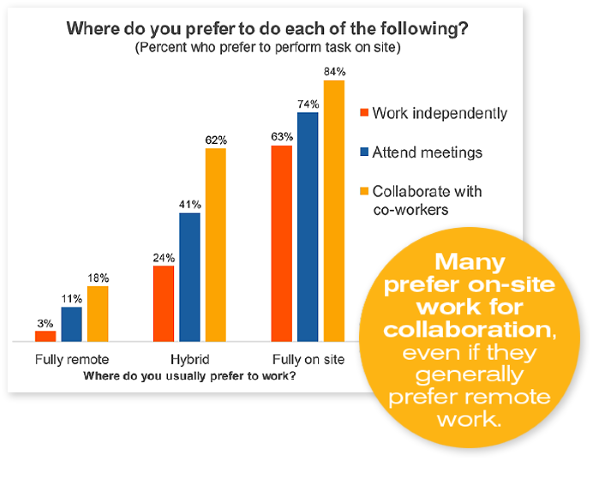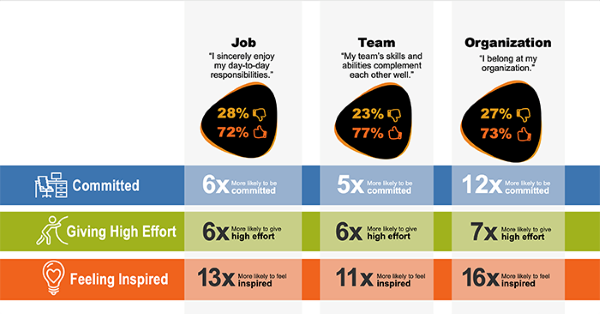Two years ago, belonging and purpose were in the mix of factors that influence employee engagement but have very quickly risen to prominence as massive shifts occur in how work is experienced. Essentially becoming currencies of culture, the recent data we’re seeing indicates the degree to which employees feel like they belong and how they see purpose in their work are the two main drivers of how much energy and attention they are willing to give any one project.
While belonging and purpose are especially important no matter how or where employees are working, there are differences in the way they are experienced when working in a remote or hybrid model. In those scenarios, we see things like isolation and disconnectedness come into play, where employees feel a lack of support or don’t have a clear line of sight into how their work matters. Because of this, the way we foster belonging and communicate purpose to our remote and hybrid teams will need to be intentionally different.
Let’s start with the questions many employers are facing: Where should their employees work? Where are they most productive? And if a new work model is introduced, no matter what it is, what impact will that have on employee commitment and performance? To help determine the answer to those questions, we surveyed employees to see, given the choice, where they prefer to work – fully remote, hybrid or fully on-site. At a high-level, the majority of people prefer to be fully remote or hybrid, but there is a subset of people who prefer to be fully on-site. We then asked specific questions about where they prefer to do different things – work independently, attend meetings, and collaborate with co-workers.

What we see in the data is that even people who prefer to work fully on-site often prefer to do independent work remotely. We also see that people’s desire to be together in person increases when the purpose is to attend a meeting and, even more so, when the purpose is to collaborate with co-workers.
What this tells us is rather than defining how and where work gets done simply based on a set schedule of days or weeks, perhaps we should consider architecting the work model around what type of work is happening. The goal is to find a balance between where employees enjoy working the most and in what scenario they are going to be most productive. We also need to consider that some employees, teams or even entire companies just aren’t going to have as much flexibility in where they work. In that case, leaders need to openly communicate about why that is, perhaps citing examples such as more collaboration or improved customer service, and reinforce the meaningful impact it has on the business.
Once you’ve established the work model that is best for your employees and your business, it’s important for leaders at all levels to understand their role in fostering a sense of belonging for their teams, given where and how they are working. Belonging can be measured in three ways: a sense of belonging with the job, the team, and the organization. It is more than just how well an employee gets along with their team (though that is important). It’s also about if they truly enjoy their day-to-day responsibilities and feel as if they are a part of the overall organization. What we see in our data is these three areas of belonging predict how committed employees are, how much effort they’re giving and how likely they are to feel inspired at work.

To further create a sense of belonging, managers and leaders should commit to helping employees see how their work really matters, connecting it to greater organizational goals and results on a regular basis. This could be by facilitating team huddles, reunions or all-hands meetings, or providing satellite workspaces for employees to work in solitude.
Branded merchandise or swag is also an easy way to show affiliation, providing an opportunity for employees to feel like they belong and are part of something bigger. Just like a favourite sports jersey, it communicates an employee’s commitment to their current “team.” As with any type of communication or gathering, these opportunities need to be authentic and meaningful. They cannot be so unstructured that employees feel it’s a waste of their time to engage.
One final and often overlooked aspect of creating a sense of belonging and purpose is IT infrastructure. When implementing a hybrid work model, companies have a responsibility to make sure their employees have what they need to do their work and interface with their co-workers – a computer, work equipment, reliable internet, etc. As we decentralize the experiences of work, moving from primarily physical to partially, if not fully, virtual, companies need to reevaluate what they are providing to help employees stay connected and how they are creating immersive online experiences that foster belonging.
No matter what the work environment is, there are vast opportunities for leaders to foster belonging and help employees understand they matter and their work has purpose. And there’s good reason to do so – employees who feel they belong at their organization are 12 times more likely to be committed, 7 times more likely to give higher effort and 16 times more likely to feel inspired.
